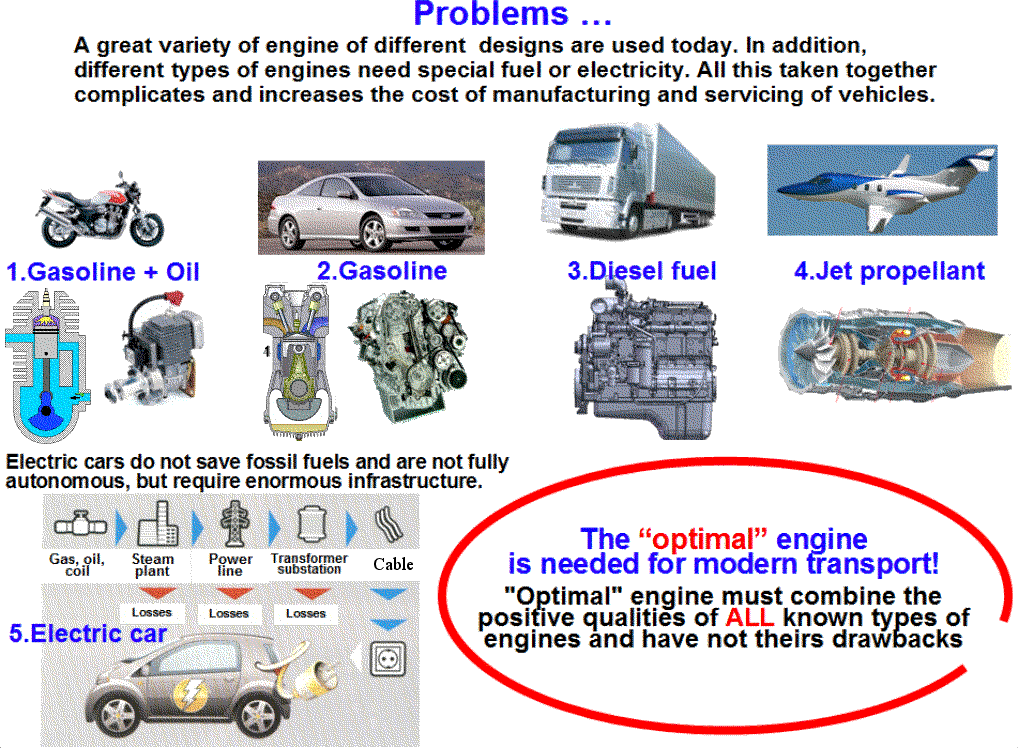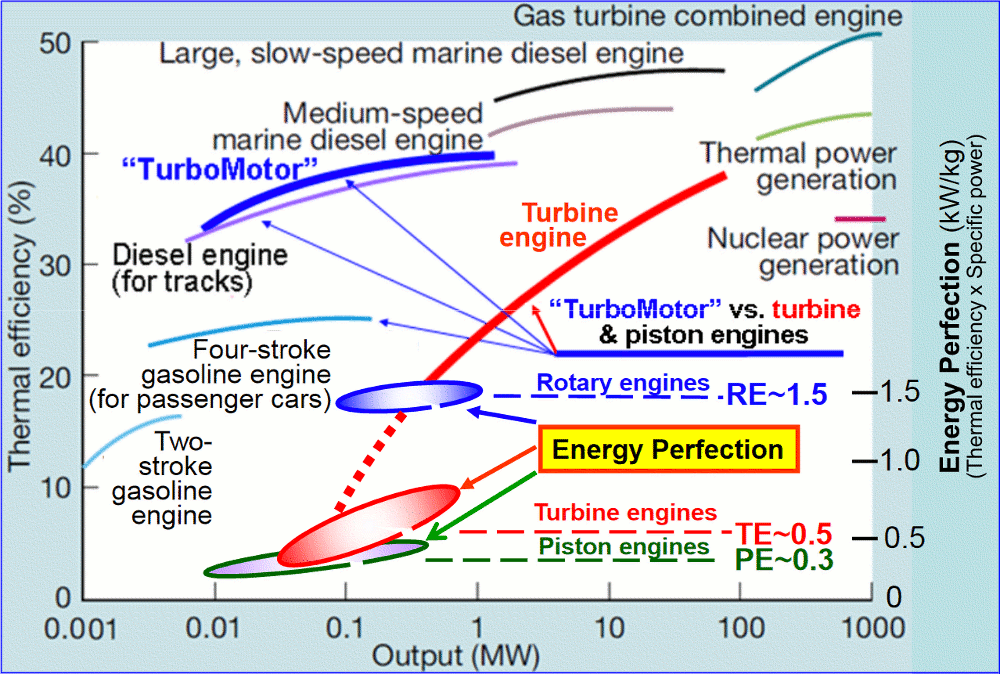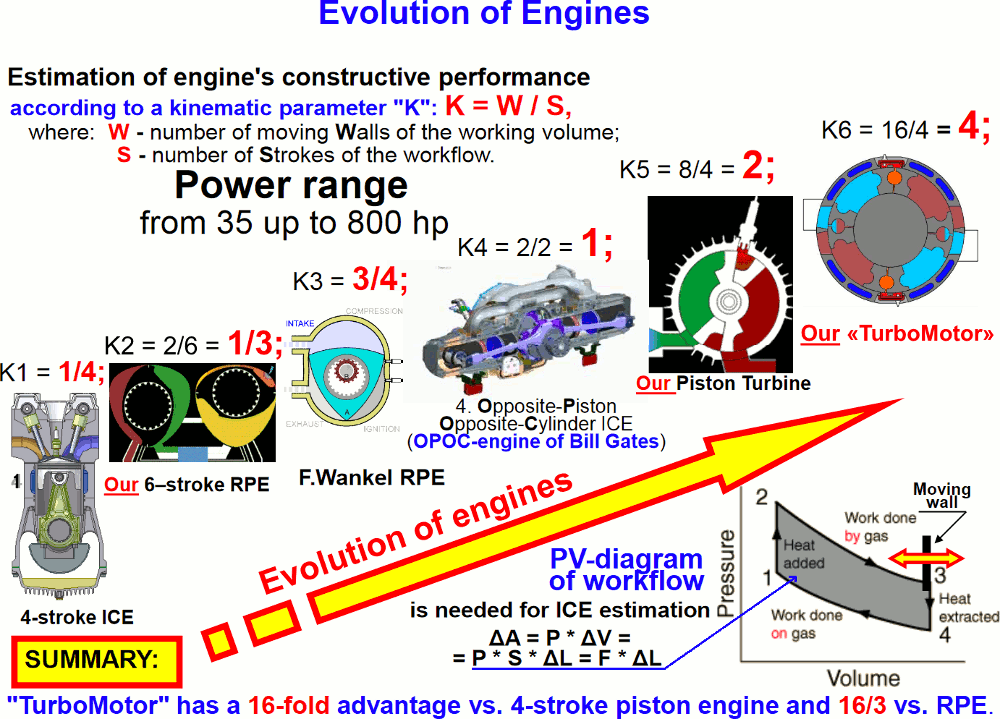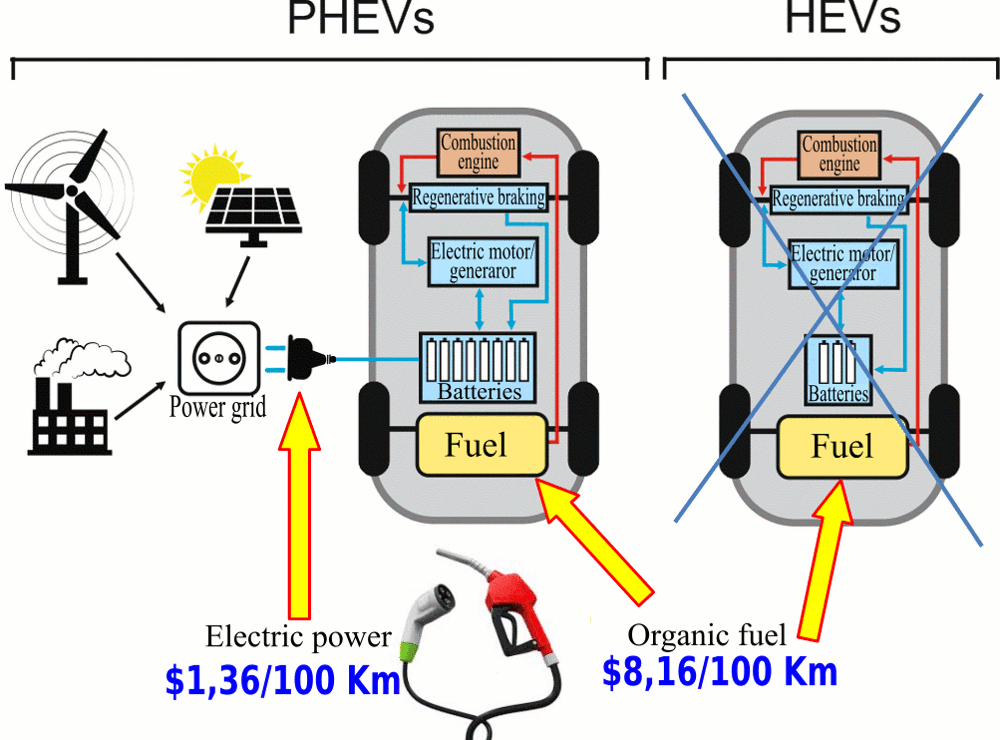Project: Engines evaluation
We set to ourselves an ambitious task: to unite in one design the positive qualities of known types of engines and to exclude their shortcomings. We call this engine "OPTIMAL".
And how to evaluate and compare such an engine with known and any others? To do this, we need the techniques that we set out below.
1. The relevance of the ICE assessment
The variety of types and specific features of vehicles is determined by the huge variety of engines used: piston engine, gas-turbine, electric motor etc ...
Therefore, it is important to have a tool for their objective comparative evaluation in order to correctly identify effective ways to improve them.
We propose to perform a comparative evaluation of the engines in 3 quantitative parameters:
- Energy perfection;
- Kinematic perfection;
- Energy potential.
2. Evaluation of ICE according to the parameter "Energy perfection"
The energy perfection of piston's and gas turbine internal combustion engines (ICEs) of various designs may be quantitatively determined in the first approximation by a method that is presented in a very simplified form below.
The energy perfection of the design of the internal combustion engine is expedient to evaluate simultaneously by 2 main parameters:
- by thermal efficiency;
- by specific weight capacity.
It is obvious that the greater the value of thermal efficiency and specific weight capacity, the more commercial and technical capabilities of ICE are realized by vehicle. Therefore, the product of the value of the engine thermal efficiency to its specific weight capacity can be called as the "Energy perfection" parameter.
To evaluate and compare the internal combustion engines of various types, we take their averaged parameters:
- the specific power of gas turbine engine (GTE) and "TurboMotor" is ~ 5 HP / kg (~ 3.7 kW / kg),
- the specific power of piston engines is 1.36 hp / kg (~ 1.0 kW / kg),
- the average thermal efficiency for piston ICE will be equal to 30% (between the Otto`s gasoline engine and diesel engine),
- the average thermal efficiency for low-power GTE (RR300 has a peak pressure of just 6.2 atm.) will be taken as ≈13%,
- the average thermal efficiency of the "TurboMotor" will be ≈40% (due to the minimum losses for internal friction).
Then the value of the parameter "Energy perfection" will be equal to:
- Piston engine: Еpe = ~ 0.3 * 1.0 kW / kg ≈ 0.3 kW / kg;
- low power GTE: Еgte = ~ 0.13 * 3.7 kW / kg ≈ 0.5 kW / kg;
- The "TurboMotor": Etm = ~ 0.4 * 3.7 kW / kg ≈ 1.5 kW / kg.
The result: the superiority of the "TurboMotor" in the parameter "Energy perfection" is:
- for piston internal combustion engines: 1.5 / 0.3 ≈ 5 times;
- for a gas turbine engine (for power less than 500 kW): 1.5 / 0.5 ≈ 3 times;
- for a gas-turbine engine (for power of 100 MW): ≈ 1, i.е. are equal, because thermal efficiency is the same ≈40%.
(reference: "Approach to High Efficiency Diesel and Gas Engines", by Tatsuo Takaishi and outhers) local copy.
3.Evaluation of ICE according to the parameter "Kinematic perfection"
The kinematical perfection of various design ICE`s (the working process of which is carried out in a closed volume) can be quantified by the method proposed by us, which is described in a very simplified form below.
The basis of this method is the theory of classical thermodynamics, in particular thermodynamic cycle of the working process of the internal combustion engine (Fig. 1). Its physical meaning in the frame of reference p and V is very simple - this is the value of the 4-dimensional area of the pV-diagram. This area in size corresponds to the work which done by the moving walls of the working cavity of the internal combustion engine for 1 full working cycle, for example, a well-known 2- or 4-stroke work cycle. The larger area of the pV-diagram corresponds to the larger work of the ICE cycle and, accordingly, the bigger efficiency of the conversion of the energy of hot gas into mechanical work. Thereby, the greater efficiency of the internal combustion engine means the greater degree of expansion of the hot gas: from the greatest pressure of the hot gas in the combustion chamber and to its greatest expansion, up to atmospheric pressure.
ICE can have several working volumes, each of which must have a movable wall, by which is carry out the conversion of the thermal energy of gases into mechanical work is carried out. Naturally, each movable wall must have a kinematic drive. Such a drive can be either individual for each movable wall, or may be common for all walls. Naturally, in the second case, the engine will be simpler in design, lighter, more compact and cheaper to manufacture due to fewer parts..
In addition, it must be taken into account that only one "Work stroke" performs useful work out of all strokes of the thermodynamic cycle, the remaining strokes of the working cycle are energy-consuming. Consequently, work cycles with a smaller total number of stroke are more energy efficient because of the greater specific proportion of the "Work stroke" in the full working cycle.
The quantification of the Kinematic perfection (the parameter K) of ICE of various designs is very simple: the number of movable walls (W) in the working cavity should be divided by the number of strokes of the work cycle (S), that is:
K = W / S
For example, a piston engine has in 1 cylinder 1 movable wall and 4 strokes of the working process. The result of the evaluation of its kinematic perfection will be the value:
Kpe = 1 / 4 (see. Fig.1, left).
For example, 1 section of the F.Wankel ICE has 3 movable walls in the working cavity of the section and 4 strokes of the working process. The result of the evaluation of its kinematic perfection will be the value::
Krpe = 3 / 4 (see. Fig.1, center).
One more example. The "EcoMotors" company in USA, since 2008, with financial support by Bill Gates is developing the Opposite-Piston Opposite-Cylinder engine (the "OPOC-engine"). It is a 2-stroke diesel engine which has 2 pistons moving towards each other in each cylinder. There is no gas distributing mechanism, the cylinders are purged by an air compressor. Thus, 1 cylinder of the OPOC-engine has 2 movable walls in cylinder and 2 cycles of the working process. The result of the evaluation of its kinematic perfection will be the value:
Kopoc = 2 / 2 = 1 (see. Fig.1, right).
The quantitative evaluation of the "TurboMotor" is carried out on the basis of its design parameters. It operates with 4-stroke cycle and has two 4-blade rotors which perform rotational-vibrational motion in the 1 working cavity. For the "TurboMotor" the number of movable walls of rotors in 1 working cavity will be:
W = 2 rotors * 4 blades * 2 faces = 16.
Therefore,
Ktm = 16 / 4 = 4.
 |
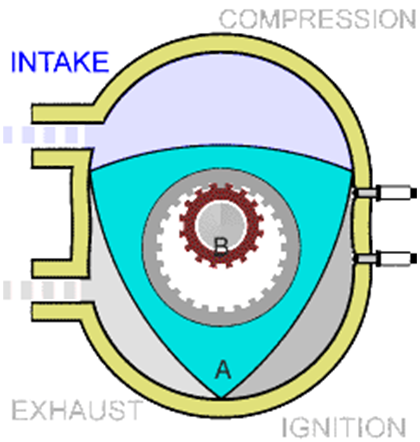 |
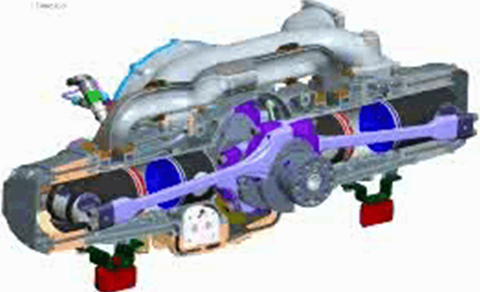 |
|
Kpe = 1 / 4 Piston engine (PR) |
Krpe = 3 / 4 Rotary-piston engine (RPE) |
Kopoc = 2 / 2 = 1 OPOC-engine of Bill Gates |
Fig.1. Quantitative estimation of ICE of different design.
Such a high value of the kinematic perfection index indicates the perspective of the design of rotary-blade ICEs. General information on the parameter "Kinematic perfection" of different types of internal combustion engine is given gelow
The Result: The superiority of "TurboMotor" in the parameter "Kinematic perfection" is:
- for piston internal combustion engines: 4/(1/4) = 16 times;
- for the RPE of F. Wankel: 4/ (3/4) = 16/3 ≈5.3 times;
- for OPOC-engine: 4/1 = 4 times.
4. Estimate of ICE according to the "Energy potential"
The energy potential of a modern transport`s electric drive in comparison with existing piston ICEs (and the "TurboMotor" too) can be estimated on the basis of a comparison of an energy capacity as parameter "Energy potential" of modern electric batteries to a hydrocarbon fuel (according to: http://madoptic.narod.ru/info/Electro.htm).
The energy capacity of a kilogram of A95 type gasoline fuel (or similar) is at the level of 47 MJ. In a more convenient system for comparison, this is 13 kWh / kg. To bring the energy intensity of a kilogram of fuel to the input of the transmission, i.e. take into account the efficiency of the power plant, use the average (and pessimistic) value of thermal efficiency for gasoline internal combustion engines. It is about 20%, therefore the power capacity of the fuel brought to the transmission input will be 2.61 kWh / kg.
Let's determine the power capacity of the electric drive. One of the best and most effective batteries manufactured by the industry at the present time is lithium-ion battery “LEV50” from “Lithium Energy Japan”. The weight of each element is 1.8 kg, the output voltage is 3.75 V, the capacity is 50 A * h, which results in an energy capacity of 187.5 W * h. Let's bring it to the unit mass and get 0.104 kWh / kg. Further, again, we will equate it to the input of the transmission to take into account the efficiency of the electric motor (on average this is about 80%), and we obtain 0.083 kWh / kg. This value will be about 10% lower if an electric motor uses an alternating current motor and requires a DC to battery voltage converter.
The result: Compare the two figures which are obtained - 2.61 kWh / kg for gasoline and 0.083 kWh / kg for the battery. The difference in the given specific energy capacity is: 2.61 / 0.083 = 31.5 times in favor of gasoline.
Consequently, the equivalent of a 50-liter petrol tank is a 1150 kg battery. Now for an ordinary car weight of about 1.5 tons, the payload is up to 500 kg. That is, an electric car carries its batteries, not passengers and a useful cargo. A stalemate - if more batteries are installed for a larger run, the more energy will be spent on moving these batteries and the efficiency of delivering the payload is significantly reduced.
The environmental friendliness of the electric drive is in many respects a relative concept. For example, according to the “Tesla”, in Singapore, when generating electricity, CO2 emissions averagely exceed 0.5 kG / kWh on all sources. Since a car (electric or conventional) consumes about 24 kWh of energy per 100 km, CO2 emissions will be about 120 g / km for an electric vehicle. At the car with petrol ICE according to manufacturers emissions will be about 170 g / km. Therefore, the difference is not very large. And in regions with a large share of electricity generation on coal, electric vehicles may even be more harmful than cars with conventional ICE.





